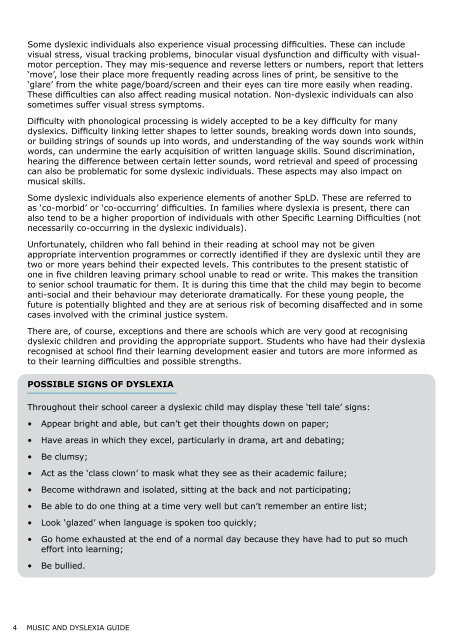TEACHER GUIDE TO MUSIC AND DYSLEXIA - Rhinegold Publishing
TEACHER GUIDE TO MUSIC AND DYSLEXIA - Rhinegold Publishing
TEACHER GUIDE TO MUSIC AND DYSLEXIA - Rhinegold Publishing
Create successful ePaper yourself
Turn your PDF publications into a flip-book with our unique Google optimized e-Paper software.
Some dyslexic individuals also experience visual processing difficulties. These can includevisual stress, visual tracking problems, binocular visual dysfunction and difficulty with visualmotorperception. They may mis-sequence and reverse letters or numbers, report that letters‘move’, lose their place more frequently reading across lines of print, be sensitive to the‘glare’ from the white page/board/screen and their eyes can tire more easily when reading.These difficulties can also affect reading musical notation. Non-dyslexic individuals can alsosometimes suffer visual stress symptoms.Difficulty with phonological processing is widely accepted to be a key difficulty for manydyslexics. Difficulty linking letter shapes to letter sounds, breaking words down into sounds,or building strings of sounds up into words, and understanding of the way sounds work withinwords, can undermine the early acquisition of written language skills. Sound discrimination,hearing the difference between certain letter sounds, word retrieval and speed of processingcan also be problematic for some dyslexic individuals. These aspects may also impact onmusical skills.Some dyslexic individuals also experience elements of another SpLD. These are referred toas ‘co-morbid’ or ‘co-occurring’ difficulties. In families where dyslexia is present, there canalso tend to be a higher proportion of individuals with other Specific Learning Difficulties (notnecessarily co-occurring in the dyslexic individuals).Unfortunately, children who fall behind in their reading at school may not be givenappropriate intervention programmes or correctly identified if they are dyslexic until they aretwo or more years behind their expected levels. This contributes to the present statistic ofone in five children leaving primary school unable to read or write. This makes the transitionto senior school traumatic for them. It is during this time that the child may begin to becomeanti-social and their behaviour may deteriorate dramatically. For these young people, thefuture is potentially blighted and they are at serious risk of becoming disaffected and in somecases involved with the criminal justice system.There are, of course, exceptions and there are schools which are very good at recognisingdyslexic children and providing the appropriate support. Students who have had their dyslexiarecognised at school find their learning development easier and tutors are more informed asto their learning difficulties and possible strengths.Possible Signs of DyslexiaThroughout their school career a dyslexic child may display these ‘tell tale’ signs:• Appear bright and able, but can’t get their thoughts down on paper;• Have areas in which they excel, particularly in drama, art and debating;• Be clumsy;• Act as the ‘class clown’ to mask what they see as their academic failure;• Become withdrawn and isolated, sitting at the back and not participating;• Be able to do one thing at a time very well but can’t remember an entire list;• Look ‘glazed’ when language is spoken too quickly;• Go home exhausted at the end of a normal day because they have had to put so mucheffort into learning;• Be bullied.4 <strong>MUSIC</strong> <strong>AND</strong> <strong>DYSLEXIA</strong> <strong>GUIDE</strong>









